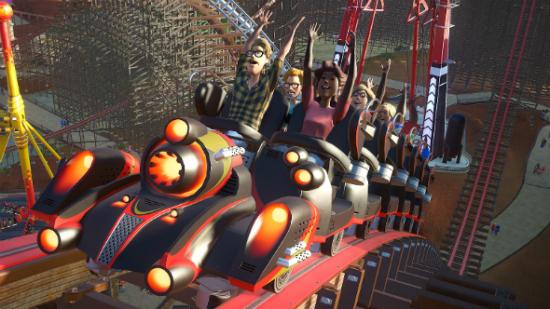Theme parks have a special place in the hearts of PC gamers beyond a certain age. For many of us, Bullfrog’s Theme Park was the entry point, letting us plonk down ready-made rides in that grainy green field then watch the rudimentary simulation unfold. I remember being as eager to see guests flying off rollercoasters and slipping around in comical vomit as I was to see a fully-functioning theme park . Then we grew up, and Rollercoaster Tycoon took over, presenting us with more elaborate challenges to build lifelike rides, and micromanaging the park to make it as profitable as possible.
Related: the best strategy games on PC.
But the once-promising genre never really evolved alongside gaming hardware, and subsequent years saw it stagnate as it got waylaid into the mobile market instead of staying on the PC (where it rightfully belonged).
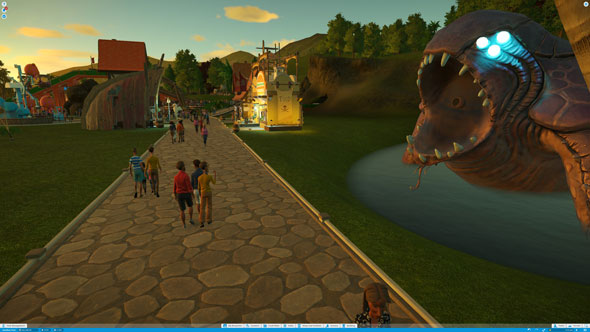
Planet Coaster is the sparkly, happy homecoming of the theme park sim to PC. Coming from Rollercoaster Tycoon stalwarts Frontier Developments, it thrives most as a design sandbox, plunging us deeper than ever into the technicalities of making every element of a park tick. It will delight the createy-sharey gaming communities, but possibly at the expense of newcomers or the less design-inclined.
You see, more than ever, Planet Coaster reminds us that designing and running a theme park is hard work; harder than building a house and managing its residents, harder even than running a city and managing its traffic. It’s complex on both the micro and the macro scale, and even if you can design the most spectacular ride in the world, making it actually work is another matter. Upon starting my first scenario in the Career mode, I was paralysed by the large green expanse of park I had to work with (especially after looking at the part of the park that was pre-built for the scenario, and seeing just how incredible my park could look if I was an architect, town planner, or some other grown-up profession along those lines).
During my first hour of play, the only monument to my creativity was a pre-fab pirate toilet (it was a pirate-themed park) that I’d slathered with seaweed; it felt symbolic somehow, and not in a good way…
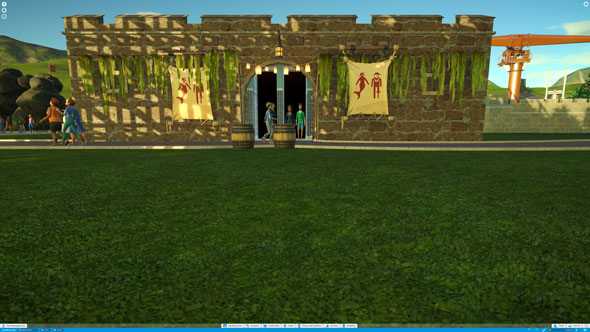
But it was also a learning experience, teaching me that buildings and rides can’t exist in isolation in Planet Coaster. Any ride and accompanying queue you put in your park is just the skeleton, which will amount to nothing if you don’t embellish it with bespoke decorations, special triggered events at specific points of the ride, and something for the guests to feast their eyes on as they wait for it (a digital timer every ten metres saying how long they have left to queue doesn’t count). Even the paths around the park need to shine.
All those fancy decorations – the sculpted rock formations, the perfectly-timed cannon explosions just as rapids ride descends into an underground cave (one of my finer design moments), the trees and foliage – are registered by the park guests, building up their enjoyment, and improving your park’s rating which in turn attracts more customers. Much like how Disney theme parks use forced perspective to make Cinderella’s Castle appear bigger than it is, little details like how you design your queues matter, with a shorter one that appears long and straight likely to be more of a turnoff for guests than a tightly-wound one twice its length (incidentally, the snaking Theme Park queue style works quite well here, so you’re not completely screwed if that’s the extent of your theme park sim experience).
Eventually, I snapped out of my pre-build paralysis and began throwing down some pre-fab rides (trying to put off the challenge of building my first coaster for as long as possible). There’s the best part of 30 rides to choose from – not including coasters and track rides – spanning the gamut from swingy pendulum ships, to Ferris wheels, to that horrible faster variant of teacups that spins around on a wavey surface and is usually accompanied by garish ’80s disco lights and gabba music (thankfully, you can select the music in Planet Coaster). On the topic of archaic theme park rides, I was slightly disappointed to see that bumper cars were not on the roster.
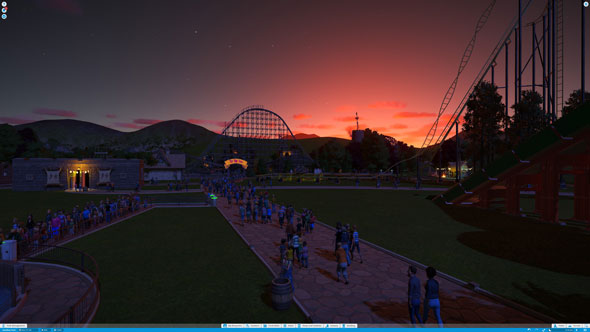
Seeing as most of the above rides weren’t available in my particular scenario and I didn’t have the money to research new ones, I slapped down a ‘Wild Blue’ (little biplanes spinning on a giant mechanical arm) and built a small castle wall around it, hoping that that would satisfy the guests. Sadly, they apparently have better taste than me, and the ‘Scenery’ rating for the ride only rose up to 12%. 20 minutes and many, many props later, I got it up to a perfectly respectable 47%, and was ready to go.
The same level of care needs to go into every ride in your park if it’s to attract people, though some people might grow tired of the game’s high demand for attention to the tiniest details; if Six Flags and the UK’s glorious Thorpe Park can succeed without blasting our senses with endless decorations, then why shouldn’t I? I powered on, speed-building a parade of shops and creating a large pond with an animatronic Kraken emerging from it to startle (and hopefully delight) my design-savvy guests. My objectives for the scenario were simply to rake in a certain amount of money and to attract a certain amount of guests, and I turned my focus to the business side of the park.
Clicking on the small Park Management bar in the bottom left corner of the screen, you get presented with all the graphs and data relating to guest demographics, ride profitability, staff happiness, and so on. This is where you can decide which rides are worth keeping open, which are perhaps due for cheaper ticket prices, and whether to raise you can afford to raise the price of the famous Chief Beef burgers. There is also the Research tab, where you invest money into new rides in the Career and Challenge modes, and the Marketing tab, where you can run a number of campaigns to target specific guest demographics. There’s definite tweaking to be made, but people coming here expecting to devise elaborate strategies to reel in the dollar will be disappointed however, as the actions you can take in the Marketing screen add up to little more than boosters.
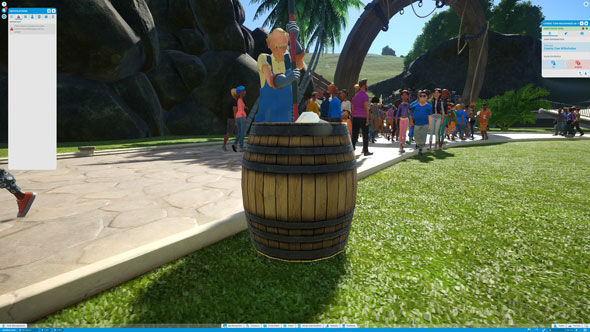
Most of the management you’ll be doing in Planet Coaster won’t be in the Park Management screen, but by observing the park directly. Are the queues getting too long on your rapids ride? Add more rafts. Are people gravitating towards one corner of the park way more than another? Build a grand parade (or a monorail) connecting it all together. Or perhaps you can milk an extra dollar or two per person out of your most popular ride (because a theme park ain’t a charity now, is it?). All of this is crucial to creating a flow to your park – shepherding people from ride to ride to snack to toilet then back to ride in order to keep them merrily spending.
So the design aspect of Planet Coaster dominates the management, and it’s a testament to the guest AI and game’s systems that park layout has such a visible impact on your park’s success. But at no point did I really feel like my business acumen was tested; it’s easy to make your park profitable even if it has all the aesthetic charm of a clay quarry. Bankruptcy is pretty much a non-existent threat, and while in the Challenge Mode (like Sandbox, but with financial restrictions and optional objectives) you can increase the difficulty to make guests more pissy and rides less reliable, that simply scales the challenge rather than deepening it.
After laying down some basic rides, I decided to branch away from my ‘original Theme Park’ habits. In order to become the next Busch Gardens, my park needed another set-piece – something spectacular to distract the guests (and me) from the wonderful dev-built part of the park that I felt was mocking my lack of design nous.
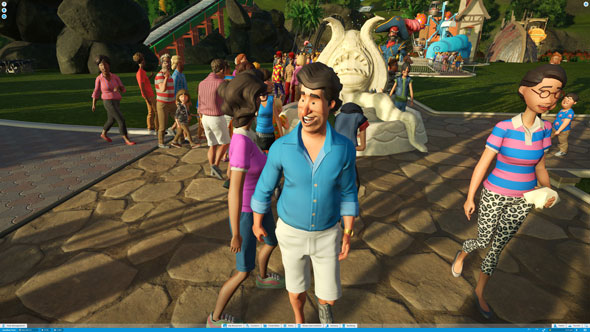
It was time to build a rollercoaster.
Coming into Planet Coaster, the extent of my knowledge about rollercoaster design is that they’re made out of steel and powered by fairy dust. So I was a little frustrated to find that the game assumed I knew that chain lifts couldn’t be built on curved stretches of track, or that different types of coaster are better catered towards different types of loops and turns. It took me a good three hours to build a coaster that passed the testing and didn’t just roll back down every incline due to a lack of momentum.
For all my frustration and exasperation that it didn’t ‘just work’, I felt genuinely elated when the monstrosity finally started functioning; I was so chuffed, in fact, that I blithely ignored the tests results showing that it incited far more ‘Fear’ than ‘Excitement’ in people, and made them a little queasy too. Screw it. It worked, and the people should be grateful; you never heard Neil Armostrong and co. complaining that they felt sick or scared on their round trip to the moon, did you?
And here it is, my foray into rollercoaster building – The Twisted Squid Tail.
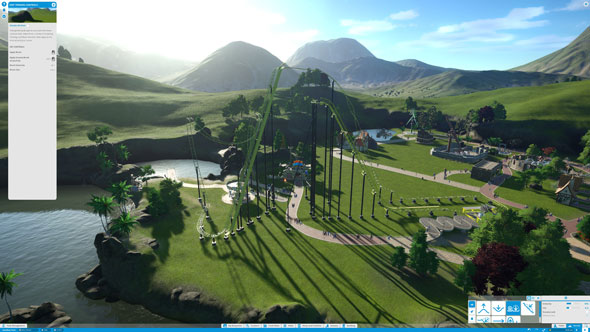
Towering far above any pre-fab coaster in the game, the vision I had when making this was something of a mix between Oblivion and one of those fancy hydraulic launcher coasters that torpedoes you from nought to 80 in one second. The reality was that when I opened it, literally not a single person wanted to ride the accursed thing because it ‘looked too intense’, and I had to cut off two crucial parts of it so that it ended up looking like this…
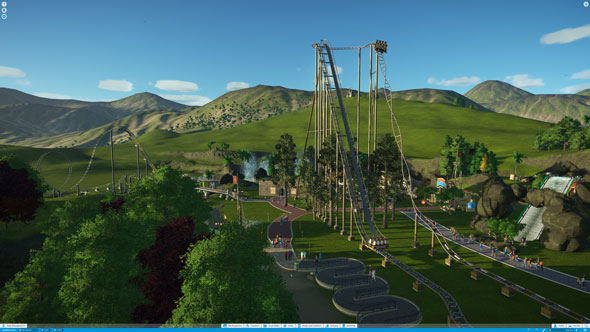
Even then, it took plenty of tests and tweaks to finally get those Excitement-Fear-Nausea levels right, as I monitored the heatmaps of where the ride needed adjusting. Little things like making sure that the vertical drop didn’t get too close to people on the ground below, trim brakes to slow the cart down as it turned the corner back into the station, and ensuring the chain lift wasn’t going so slowly that people got bored, nor so fast that it reduced the steady buildup of tension as it ascended.
Building my first rollercoaster was an ordeal, but in that satisfying way reminiscent of dying to a boss in Dark Souls or unsuccessfully launching yet another rocket in Kerbal Space Program. For design ignoramuses like me, it was quite literally a steep learning curve, but once I had that breakthrough and made a coaster that people wanted to ride, I felt compelled to improve my craft. There’s fun to be had in monitoring your rides and tweaking them to perfection over time – similar to the mundane satisfaction one may get from adding more fans and messing around with the cooling in their PC, then overclocking the GPU to appreciate those incremental performance boosts.
While folk fluent in rollercoaster design will take joy in churning out custom coasters that weave through terramorphed caves then emerge onto majestic, perfectly-timed firework displays, for amateurs like me there’s a simple but profound pleasure in seeing the faces of park guests riding – and clearly loving – your flawed creations.
That’s in large part thanks to the unique visual style of the game’s denizens. The rides and objects in the world go for the realistic look, reminding us that this is a meticulous simulator that’s true to the rollercoaster types you find in real life. But once your park is in full flow and you’re at the stage of hovering around and admiring it in action, then what you’ll really be looking at is the people in it, and their reactions to what you created. The character designs build on those of Frontier’s Rollercoaster Tycoon 3. These playdough-looking types appear simple – with thick stuck-on eyebrows and pinprick eyes that turn into different shapes to emphasise different emotions – but they’re wonderfully expressive;
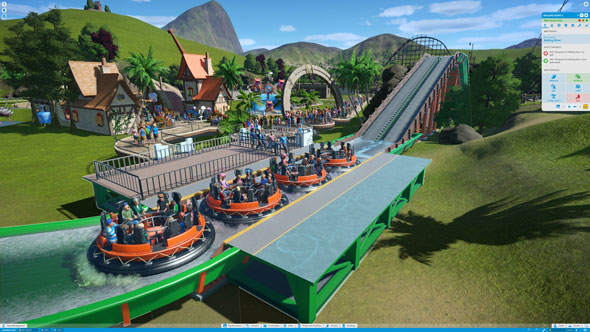
The guests walk around as individuals, couples and families of all randomly-generated shapes and sizes, looking around with unbridled wonder at every strange piece of design adorning even the most slapdash of parks. The insides of their cheeks flap as they hurtle down a coaster at 100mph, they point, laugh, jump around excitedly, and throw their fists in the air to cheer on your in-park entertainers. These people are the soul of your park, and their cheery disposition will give even the most neurotic, self-deprecating of park designers a warm feeling of validation. Planet Coaster is a testing game, but its welcoming presentation encourages you to stick with it, to keep pushing (even if you’re not much good at it) so you can get to that rewarding point where your park’s in full swing.
There’s no question about whether Planet Coaster is a ‘good’ game. It’s great. The big question is whether it caters for those who fantasise about running a theme park as a business, as well as the kinds of creative masterminds who are already sharing their incredible creations on the Steam Workshop. It’s already clear that Planet Coaster will have a buzzing community of creators that’ll provide us with hundreds of thousands of free rides, scenes and props for our parks, but if you rely too much on those then you may find yourself with little else to do. The ‘Career’ mode is just a series of disparate scenarios with nothing to bind them and no compelling management mechanics to incentivise getting through. And as I mentioned earlier, design dictates the vast majority of the game, with interesting management ideas regarding staff training, marketing, and so on not being explored as much as they could.
But if you are creative and have a vision for a park – whether it’s recreating The Magic Kingdom, American Adventure Theme Park (anyone?), or plucking some wonderful, surrealist conception straight from your dreams, then Planet Coaster will let you realise it, so long as you have the patience to dig into its seemingly bottomless toolbag. For people like me, meanwhile, there’s a satisfaction to the steady learning process and problem-solving of tweaking a rollercoaster to make it less nauseating and more exciting, or working out why guests aren’t visiting certain parts of the park as much as others.
